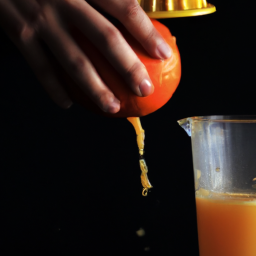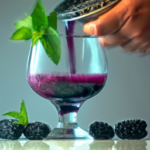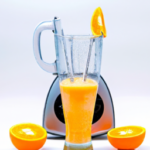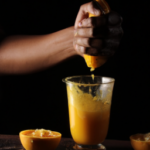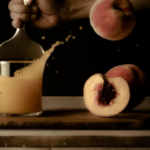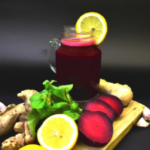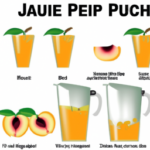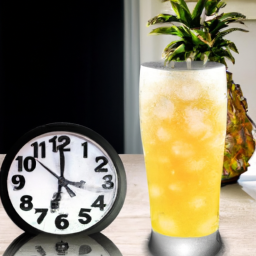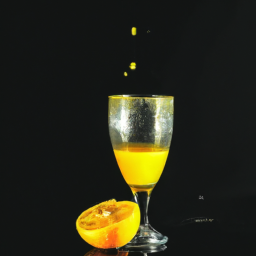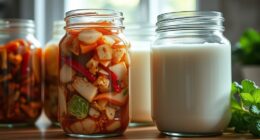I absolutely love strawberries! Their sweetness, juiciness, and incredible versatility make them stand out. Juicing them is one of my favorite ways to enjoy these delicious berries. If you’re new to the idea of juicing strawberries, you might be wondering how to get started. Don’t worry, the process is actually quite simple, and I’ll guide you through it, step by step.
First things first, you’ll want to make sure you’re choosing the right strawberries for juicing. Look for berries that are bright red, plump, and firm to the touch. Avoid any that are soft, bruised, or have moldy spots.
Once you have your perfect berries, it’s time to wash them thoroughly and remove the stems and leaves. From there, you’ll be ready to start juicing!
Key Takeaways
- Choose bright, plump, and firm strawberries and avoid soft, bruised, or moldy ones
- Wash thoroughly before removing stems and leaves with a gentle twist or huller tool
- Use a high-quality juicer or blender and add a small amount of water to loosen the juice
- Strain through a fine-mesh strainer and use a masticating juicer for nutrient preservation
Choosing the Right Strawberries
You gotta pick the juiciest strawberries if you want to make the perfect strawberry juice! When it comes to picking strawberries, it’s important to look for ripeness. The riper the strawberries, the sweeter and juicier they’ll be.
Look for strawberries that are bright red, plump, and firm to the touch. Avoid any strawberries that are mushy, bruised, or have mold on them.
It’s also important to consider the seasonal availability of strawberries. Strawberries are at their peak during the spring and summer months, so that’s the best time to find the juiciest and most flavorful strawberries. However, with advancements in technology and global trade, strawberries are available year-round in most grocery stores.
After selecting the best strawberries, it’s time to move onto the next step: washing them thoroughly.
Washing the Strawberries
Before starting, make sure to rinse the fruit with cool water to remove any dirt or debris. Strawberry washing is an essential step in preparing the fruit for juicing. Many people make the common mistake of washing the strawberries after removing the stem and leaves, which can lead to the fruit absorbing more water and losing some of its flavor.
To properly wash the strawberries, follow these simple steps:
- Fill a large bowl with cool water.
- Place the strawberries in the bowl and gently swirl them around to remove any dirt or debris.
- Remove the strawberries from the water and pat them dry with a clean towel.
Once the strawberries are washed and dried, it’s time to move on to the next step of removing the stem and leaves.
Removing the Stem and Leaves
After washing the strawberries, it’s a piece of cake to remove the stems and leaves with just a gentle twist – it’s as easy as pie! I usually start by holding the strawberry by the stem and gently pulling it towards me with my other hand. If the stem is particularly stubborn, I’ll use a paring knife to gently cut it out. Once the stem is removed, the leaves should come off easily as well.
If you’re looking for stemless strawberries, you can also try using a strawberry huller tool. This nifty gadget allows you to remove the stem and leaves in one swift motion. Alternatively, you can also use a straw to remove the stem by inserting it at the bottom of the strawberry and pushing up towards the stem. These alternative juicing methods can save you time and effort, especially if you’re working with a large batch of strawberries. Now that the strawberries are stem-free, it’s time to move on to preparing them for juicing.
Preparing for Juicing
Now that you’ve removed the stems and leaves, it’s time to get your strawberries ready for blending. Before you start juicing, it’s important to make sure your strawberries are properly prepared.
Blending techniques can vary depending on your equipment and desired consistency, but there are a few steps you can take to ensure a smooth and delicious juice.
First, wash your strawberries thoroughly to remove any dirt or debris. Then, remove any remaining green or white parts that may have been missed during the previous step. Slice the strawberries into smaller pieces to make them easier to blend.
Depending on the size of your blender or juicer, you may need to work in batches to avoid overfilling the container. By taking these pre-juicing preparation steps, you can help to ensure that your strawberry juice turns out perfectly smooth and full of flavor.
As you prepare to move on to the next step of juicing the strawberries, it’s important to remember the importance of proper preparation. With your strawberries sliced and ready to go, you’re one step closer to enjoying a delicious and refreshing glass of strawberry juice.
Juicing the Strawberries
Now that we’ve prepared our strawberries for juicing, it’s time to extract as much juice as possible while maintaining the maximum nutrients and flavor. To do this, I’ve got a few tips that I’ve found helpful.
First, make sure to use a high-quality juicer that’s powerful enough to extract all the juice from the strawberries.
Second, be gentle when pushing the strawberries through the juicer to avoid damaging the nutrients and flavor.
Finally, juice your strawberries as soon as possible after preparing them to avoid any loss of nutrients or flavor.
Tips for Extracting Maximum Juice
To get the most juice out of your strawberries, you should first wash them thoroughly, then hull them using a sharp knife or huller, and finally use a juicer or blender to extract as much juice as possible. Here are some tips to help you extract maximum juice from your strawberries:
-
Use ripe strawberries: Ripe strawberries are softer and juicier than unripe ones, so they’ll yield more juice.
-
Cut the strawberries into small pieces: By cutting the strawberries into small pieces, you’ll make it easier for the juicer or blender to extract the juice.
-
Use a high-powered juicer or blender: A high-powered juicer or blender will be able to extract more juice from the strawberries than a low-powered one.
-
Add a little water: Adding a small amount of water to the strawberries before juicing can help to loosen the juice and make it easier to extract.
-
Use a strainer: If you’re using a blender to juice your strawberries, you may want to strain the juice through a fine-mesh strainer to remove any pulp or seeds.
By following these tips, you can ensure that you extract as much juice as possible from your strawberries. However, it’s also important to avoid loss of nutrients and flavor, which we’ll discuss in the next section.
Avoiding Loss of Nutrients and Flavor
In order to preserve the maximum nutritional value and flavor of your strawberry extract, it is important to take certain precautions during the extraction process. Here are some juicing techniques you can use to avoid loss of nutrients and flavor:
First, make sure to use a high-quality juicer that can extract the juice without damaging the nutrients. Avoid using a centrifugal juicer, as it can heat up the juice and destroy some of the vitamins and enzymes. Instead, opt for a masticating juicer that slowly grinds the fruit and preserves the nutrients. Second, make sure to juice the strawberries immediately after washing them. This will prevent the loss of nutrients that can occur when the fruit is exposed to air for too long. Finally, avoid adding water or other liquids to the juice, as this can dilute the flavor and reduce the nutrient density.
To further emphasize the importance of flavor preservation when juicing strawberries, here’s a table comparing the nutrient content and flavor of fresh strawberries versus processed strawberry juice:
| Nutrient/Flavor | Fresh Strawberries | Processed Strawberry Juice |
|---|---|---|
| Vitamin C | High | Low |
| Fiber | High | Low |
| Sugar | Low | High |
| Tartness | High | Low |
As you can see, processed strawberry juice has lower nutrient content and a sweeter, less tart flavor than fresh strawberries. By using the right juicing techniques and avoiding dilution, you can preserve the natural flavor and nutrients of your strawberry extract.
When it comes to adding sweetness to your juice, there are a variety of options available.
Adding Sweetness
Who wouldn’t want to amplify the already overwhelming sweetness of a strawberry by adding sugar? However, not all of us have a sweet tooth, and some of us might be trying to avoid refined sugars. Luckily, there are several ways to add sweetness to your strawberry juice without compromising on flavor or health benefits.
-
Using natural sweeteners: Instead of refined sugars, you can use honey, maple syrup, or agave nectar to sweeten your strawberry juice. These natural sweeteners not only add sweetness but also contain essential nutrients and antioxidants that benefit your body.
-
Flavor combinations: Adding complementary flavors such as mint, basil, or ginger to your strawberry juice can enhance the sweetness while giving a refreshing twist to the taste. You can also try adding lemon or lime juice to balance the sweetness and acidity levels.
-
Adjusting ripeness: Choosing ripe strawberries with a natural sweetness can make a huge difference in the taste of your juice. You can also add a pinch of salt to bring out the natural sweetness of the fruit.
Now that you know how to add sweetness to your strawberry juice, let’s move on to some exciting recipe ideas that’ll make your taste buds dance with joy.
Recipe Ideas
So, now that we know how to juice a strawberry, let’s talk about some delicious recipe ideas!
One of my favorite ways to enjoy fresh strawberry juice is by simply adding some water and a bit of honey for sweetness.
Another option is to blend it with some banana and yogurt for a refreshing strawberry-banana smoothie.
And if you’re in the mood for something a little tangy, try making some strawberry lemonade by combining fresh strawberry juice with lemon juice and sugar.
Trust me, these recipes are sure to satisfy your strawberry cravings!
Simple Strawberry Juice
To make a delicious strawberry juice, you’ll need fresh strawberries, water, sugar, and a blender. Start by washing and hulling a pound of fresh strawberries and blending them with one cup of water until smooth. Then, strain the mixture through a fine mesh sieve to remove any seeds or pulp. Add sugar to taste, starting with ¼ cup, and blend for a few more seconds until the sugar is fully dissolved. Chill the juice in the refrigerator for at least an hour before serving.
Flavor variations are endless when it comes to strawberry juice. Try adding a splash of lemon juice for a tangy twist or a handful of fresh mint leaves for a refreshing aroma. Not only is strawberry juice delicious, but it also comes with numerous health benefits. Strawberries are packed with antioxidants, fiber, and vitamin C, which can help boost immunity, improve skin health, and regulate digestion. So, grab some fresh strawberries and blend up a glass of sweet and healthy strawberry juice today! In the next section, I will share a recipe for a mouthwatering strawberry-banana smoothie.
Strawberry-Banana Smoothie
I hope you enjoyed learning about making simple strawberry juice. If you’re looking to switch things up, I highly recommend trying a strawberry-banana smoothie!
This smoothie is a classic and is always a crowd-pleaser. To make a strawberry-banana smoothie, you’ll need to blend together fresh strawberries, a ripe banana, and your choice of liquid (I prefer almond milk).
Blending techniques are important here, as you want the smoothie to be smooth and creamy. I recommend starting on low and gradually increasing the speed to ensure everything is well-blended. If you want to add some extra flavor or nutrition, you can also incorporate alternative fruits like blueberries or mango.
Now that you know how to make a delicious strawberry-banana smoothie, let’s move on to another refreshing strawberry drink – strawberry lemonade.
Strawberry Lemonade
You’re going to love this refreshing drink – did you know that lemonade is the second most popular drink in the US, after water?
Adding fresh strawberries takes it to the next level! Not only do strawberries add a sweet and tangy flavor to the lemonade, but they also provide a boost of antioxidants and vitamin C.
Lemon, on the other hand, contains citric acid which aids digestion and helps to detoxify the body.
There are many variations of strawberry lemonade that you can try. Some people prefer a sweeter version and will add more sugar or honey, while others might add a sprig of mint or a dash of ginger for an extra kick.
Another popular variation is to muddle the strawberries instead of juicing them, which will give the drink a slightly different texture.
Regardless of how you choose to make it, strawberry lemonade is a perfect drink for a hot summer day.
As for storage and preservation, the best way to keep your strawberry lemonade fresh is to refrigerate it. It will last for several days, but the flavor may start to deteriorate after a day or two.
If you want to prepare it in advance, you can mix the lemon juice and sugar together and store it in the fridge, then add the strawberries and water when you’re ready to serve.
Storage and Preservation
Properly storing your strawberries is key in preserving their freshness and flavor. To extend the life of your strawberries, start by removing any damaged or bruised berries from the container. Then, rinse the strawberries under cold water and let them dry completely before storing them in the refrigerator.
Be sure to place them in a container with a lid or cover them with plastic wrap to prevent moisture from getting in. If you want to preserve your strawberries for a longer period of time, consider freezing them. There are many freezing techniques you can try, such as slicing the strawberries and laying them out on a baking sheet before freezing them.
You can also make DIY strawberry syrup by blending strawberries with sugar and water, then storing the mixture in the refrigerator or freezer. No matter which method you choose, be sure to label and date your strawberries so you can keep track of how long they’ve been stored.
With proper storage and preservation techniques, you can enjoy fresh, delicious strawberries for weeks to come.
Frequently Asked Questions
Can I juice strawberries with the stem and leaves still attached?
Absolutely not! Juicing strawberries with stems and leaves will ruin your strawberry juice recipe. It will add a bitter taste, change the texture, and make your drink unappetizing. Always remove them before juicing.
How do I know if the strawberries are ripe enough to juice?
To determine if strawberries are ripe enough for juicing, I check for a bright red color and a sweet aroma. Overripe berries can cause juicing challenges, so it’s best to use fresh, firm fruit.
What other fruits can I add to strawberry juice for a different flavor?
Looking to mix up your juice game? Juicing combinations are endless, and strawberry is a great base. Try exploring flavor profiles by mixing fruits with strawberries. Some great options include banana, pineapple, and peach.
Can I use a blender instead of a juicer to make strawberry juice?
Yes, you can use a blender to make strawberry juice, but it will result in a pulpy texture. A juicer will produce a smoother juice without pulp.
How long does strawberry juice stay fresh in the refrigerator?
Oh boy, you’ve got yourself some fresh strawberry juice! How long will it last in the fridge, you ask? Well, my dear friend, let me enlighten you with some tips for storing it properly and the best ways to use any leftovers. Keep it sealed and chilled, and it should last for about 3-4 days. Use it as a sweet addition to smoothies or as a refreshing drink on its own. Enjoy!
Conclusion
Well folks, that’s how you juice a strawberry! It may seem like a small task, but taking the time to properly choose, wash, and prepare your strawberries can make all the difference in the taste and quality of your juice.
And don’t forget to add a little sweetness if needed to balance out the tartness. As the saying goes, "the proof is in the pudding,"or in this case, the juice. So why not give it a try?
Experiment with different recipe ideas and see what works best for you. And remember, with a little patience and attention to detail, you can create a delicious and healthy beverage that will satisfy your taste buds and nourish your body.
Happy juicing!
Ilana has been a vegan for over 10 years. She originally made the switch for health reasons, but soon found herself becoming more and more passionate about the ethical and environmental implications of a vegan lifestyle. Ilana is the author of The Graceful Kitchen, a blog all about veganism. She loves to cook up delicious and nutritious vegan meals, and share her recipes with others who are interested in leading a cruelty-free life. Ilana is also a strong advocate for using whole foods as the foundation of a healthy diet, and believes that going vegan is one of the best ways to achieve this.

